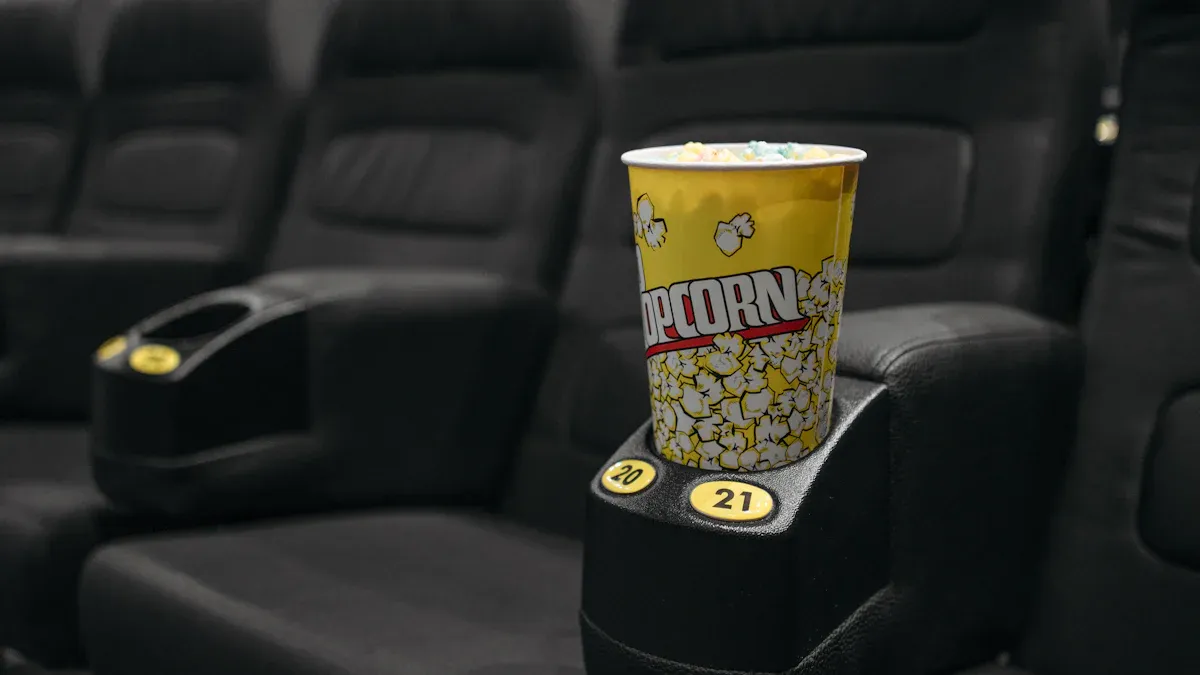How to use flashlights with multiple light modes for different tasks

Flashlights with multiple lighting modes offer unmatched versatility. You can adapt them to various tasks, from outdoor adventures to emergencies. Understanding flashlight using techniques ensures you maximize their potential. Each mode serves a unique purpose, whether you need bright illumination or energy efficiency. A well-chosen flashlight becomes an essential tool for everyday life.
Key Takeaways
Pick the right flashlight mode for your job. Use high mode to see clearly, low mode to save power, strobe mode to stay safe, and SOS mode for help in emergencies.
Practice changing modes so you can switch quickly when needed. Knowing how your flashlight works makes it safer and easier to use.
Take care of your flashlight by using the right batteries, keeping it clean, and storing it safely. This helps it work well and last longer.
Overview of Flashlight Light Modes
High Mode for Maximum Illumination
High mode delivers the brightest light your flashlight can produce. This setting is ideal for situations requiring maximum visibility. Whether you're exploring a dark trail or working in poorly lit areas, high mode ensures you see every detail. The brightness level varies depending on the flashlight's design. For example:
Lumen Range | Typical Uses |
|---|---|
Law enforcement, construction workers, campers | |
1000 - 3000 lumens | Military, search and rescue teams, hunters |
Deep sea divers, firefighters, military personnel | |
7000 - 25000 lumens | Extreme performance units for specialized tasks |
Choose a flashlight with the right lumen output for your needs. A tactical flashlight often offers high mode for critical tasks.
Low Mode for Energy Efficiency and Close-Range Tasks
Low mode provides a dimmer light, conserving battery life while offering sufficient illumination for close-range activities. Use this mode for reading, camping, or navigating indoors. It reduces glare and prevents eye strain. Multi-purpose flashlights often include this mode to balance brightness and energy efficiency.
Strobe Mode for Self-Defense and Disorientation
Strobe mode emits a pulsating light designed to disorient potential threats. This feature enhances personal safety in emergencies. It can also serve as a safety light for cyclists, making them visible to drivers during the day. At night, strobe mode provides a bright light pulse while maintaining medium brightness, ensuring visibility without overwhelming others.
SOS Mode for Emergency Signaling
The SOS mode uses Morse code to signal distress. It flashes three short, three long, and three short bursts of light. This universal signal is easy to recognize and repeat, making it effective for rescue operations. A 3-in-1 flashlight with SOS mode can be a lifesaver in survival scenarios.
Specialized Modes (e.g., Red Light, UV Light, or Adjustable Beam)
Specialized modes cater to specific needs. Red light preserves night vision, making it perfect for stargazing or wildlife observation. UV light aids in detecting stains or counterfeit items. Adjustable beams allow you to focus the strongest portable beam on a target or widen it for broader coverage. These features make 3-in-1 flashlights versatile tools for various tasks.
Practical Applications of Flashlight Light Modes

High Mode for Outdoor Adventures and Work Environments
High mode provides intense brightness, making it perfect for outdoor activities like hiking or camping. You can use it to illuminate trails, spot wildlife, or set up camp in the dark. In work environments, high mode ensures visibility in poorly lit areas, such as construction sites or warehouses. A tactical flashlight with high mode can also assist in search-and-rescue missions, where every second counts.
Low Mode for Reading, Camping, and Power Conservation
Low mode is ideal for tasks requiring minimal light. You can use it for reading a book, navigating a campsite, or performing close-up tasks without disturbing others. This mode conserves battery life, making it a reliable choice for extended use. LED flashlights often excel in this mode, offering consistent and energy-efficient lighting.
Strobe Mode for Personal Safety and Emergency Situations
Strobe mode enhances self-defence by disorienting potential threats. It can also improve visibility in emergencies. For example:
Joggers and cyclists use strobe lights to reduce accident risks.
Construction workers rely on strobe lights to stay visible in hazardous areas.
Families have used strobe alarms to deter intruders during home invasions.
This mode proves invaluable for both self defence and safety in public spaces.
SOS Mode for Survival Scenarios and Rescue Operations
The SOS mode is a lifesaver in emergencies. It signals distress using Morse code, making it easy for rescuers to locate you. Whether you're stranded in the wilderness or facing a natural disaster, this mode ensures you can call for help. Many tactical flashlights include this feature, emphasizing their utility in survival situations.
Specialized Modes for Niche Uses (e.g., Night Vision, Inspection, or Hunting)
Specialized modes cater to unique needs. Red light preserves night vision, making it useful for stargazing or hunting. UV light helps detect counterfeit items or stains. Adjustable beams allow you to focus light on specific areas, aiding in inspections or repairs. These features make flashlights versatile tools for various niche applications.
Tips for Flashlight Using and Maintenance

How to Switch Between Modes Seamlessly
Switching between modes on your flashlight should feel intuitive. Familiarize yourself with the button or switch mechanism. Many flashlights use a single button for cycling through modes. Press it lightly for quick changes or hold it down for advanced settings. If your flashlight has a rotary dial, turn it gently to select the desired mode. Practice flashlight operation in a safe environment to build muscle memory. This ensures you can adjust settings quickly during emergencies or tasks requiring precision.
Battery Care and Replacement for Longevity
Proper battery care extends the life of your flashlight. Use the right battery type for your device. Alkaline batteries are affordable and reliable for general use. Lithium batteries offer higher voltage and longer shelf life, making them ideal for outdoor adventures. Rechargeable options like NiMH and Li-ion batteries are eco-friendly and provide consistent power.
Battery Type | Voltage Range | Characteristics |
|---|---|---|
Nickel-Metal Hydride | 1.2V | Rechargeable, eco-friendly, reliable power, suitable for various flashlight sizes |
Lithium-ion | 1.5V - 3.7V | Higher voltage, lightweight, excellent performance, ideal for high-drain devices |
Store batteries in a cool, dry place to prevent corrosion. Remove rechargeable batteries if you won’t use the flashlight for a long time. This avoids unintentional drainage and preserves battery health.
Cleaning and Storing Your Flashlight for Optimal Performance
Regular cleaning keeps your flashlight in top condition. Wipe the exterior with a slightly damp cloth to remove dirt. Clean the lens with a soft, lint-free cloth, using a lens cleaning solution if needed. Inspect the O-rings and replace them if they show wear. This maintains the waterproof seal. For deeper cleaning, follow these steps:
Dip a soft cloth in a mild cleaning solution.
Wipe the LED light covers gently in a circular motion.
Rinse with clean water to remove residue.
Dry with a clean cloth and let it air dry completely.
Store your flashlight in a cool, dry place. Avoid extreme temperatures, as they can damage internal components. Use a protective case to shield it from dust and physical damage. These practices ensure your handheld light remains reliable for years.
Flashlights with multiple modes are essential tools when used effectively. Matching the mode to your task improves safety and performance. To prepare for emergencies:
Always carry a tactical flashlight with strobe or SOS modes.
Practice switching modes to avoid fumbling in the dark.
Ensure your flashlight offers at least 300 lumens for visibility.
FAQ
How do I know which flashlight mode to use?
Choose the mode based on your task. Use high mode for visibility, low mode for close-range tasks, strobe for safety, and SOS for emergencies.
Can I use rechargeable batteries for all flashlights?
Not all flashlights support rechargeable batteries. Check the manufacturer’s guidelines. Rechargeable options like Li-ion batteries work best for high-drain flashlights.
💡 Tip: Always carry spare batteries for emergencies.
What should I do if my flashlight stops working?
Inspect the batteries and replace them if needed. Clean the contacts and lens. If the issue persists, consult the user manual or contact the manufacturer.
See Also
Explore Various Categories of Flashlights Available Today
Selecting the Ideal Flashlight for Your Home Needs
Locate Your Ideal Flashlight for Daily Use
